15 January 2024
Legacy of Liberation: The Cemeteries and Memorials of the Italian Campaign
Discover the key points of commemoration of the Commonwealth’s fallen of the Italian Campaign with this look at some of CWGC’s sites in Italy.
Italian cemeteries & memorials
Italy in World War Two

Image: Men of the Durham Light Infantry pick their path through the rubble of Monte Cassino: one of the Italian Campaign's most notorious battles (© IWM NA 14999)
With the success of the campaigns in North Africa, concluding with a crushing Allied victory in Tunisia, in May 1943 Allied planners turned their attention to the Italian homeland.
Italy was seen by some, notably British Prime Minister Winston Churchill, as “Europe’s soft underbelly” and by opening another front, Allied military strategists hoped to:
- Isolate Nazi Germany by knocking her chief ally, Italy, out of the war
- Draw German troops into Italy and away from other key target areas like northern France
- To allow time to muster sufficient forces & supplies for a cross-channel invasion of France.
- Relieve pressure on the beleaguered Soviet Union
Invasion plans were drawn up. By July 1943, ships were massing in the dockyards of North Africa and Malta, ready to ferry men and materiel to the Italian island of Sicily which would act as a steppingstone across the Mediterranean to the Italian mainland.
Churchill’s hopes that Italy would be a quick and easy victory were soon dashed. The terrain, dogged Axis resistance, and appalling weather conditions turned Italy into what US General Mark Clark described as a "tough old gut".
Despite the Italians signing an Armistice with the Allies in September 1943 and re-entering the war on the Allied side shortly thereafter, some Italian forces continued to fight alongside their German allies.
Perched high upon mountain tops, overlooking craggy valleys, or holding important river crossings, the Axis defenders under their commander Field Marshal Albert Kesselring put up a spirited resistance.
The campaign which began on the sandy beaches of Sicily on 9 July 1943 would continue for nearly two years of bitter fighting, only ending in April 1945 as Allied forces were approaching the foothills of the Alps.
Telling the story of the Italian campaign in cemeteries & memorials
Commonwealth War Graves Commission memorials and war cemeteries in Italy are some of the most beautiful in the world.
They act as permanent reminders of the struggle undertaken by British, Canadian, Indian, New Zealand, and South African servicemen to liberate Italy from the yoke of fascism.
Alongside their Allies from the United States, Poland, Brazil, Free France, and Greece, they fought a tough, costly campaign.
The serried rows of headstones in our cemeteries and the names inscribed on our memorials are testament to the harsh nature of the Italian campaign.
Some 44,500 Commonwealth casualties are commemorated in Italy, victims of the campaign’s brutal nature.
Let's take a look at some of the sites that tell the story of the struggle for the Liberation of Italy during the Second World War.
Syracuse War Cemetery

The invasion of Sicily, codenamed Operation Husky, began on 9 July 1943.
Thanks to Allied deception and subterfuge efforts, such as Operation Mincemeat, the invasion achieved relative surprise having led the Axis High Command to believe an invasion of the Balkans was the next likely Allied target.
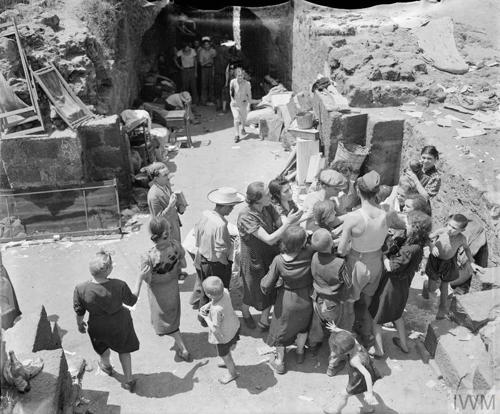 Image: Hungry Sicilian civilians are given food by RAF servicemen (© IWM CNA 1146)
Image: Hungry Sicilian civilians are given food by RAF servicemen (© IWM CNA 1146)
A combined force of 160,000 UK, Canadian, and US personnel landed by air and sea on Sicily, following Allied bombing raids.
Victory came after one month, one week and one day of fighting across the island.
Syracuse War Cemetery showcases how, despite a relatively rapid victory, fighting in Italy would be a costly affair.
Though the Allies had incurred fewer casualties than anticipated, the experience of fighting across Sicily was a foretaste of what was to come.
The rugged countryside proved ideal for defence and a relatively small German force had fought with skill and tenacity before successfully escaping across the Straits of Messina.
Just over 1,050 Commonwealth burials can be found in Syracuse War Cemetery. 134 of these servicemen are unidentified.
Syracuse itself was very close to the Allied landing zone and many of the burials in the war cemetery are of men killed during the early stages of the Sicily campaign.
Several war graves at Syracuse belong to glider pilots and airborne troops. The gliders attempted landings west of the ancient city on the night of 9-10 July, but gale-force winds blew them off course or forced them to crash land in hostile seas.
Salerno War Cemetery

Beginning in early August, German and Italian forces began to withdraw from Sicily to the Italian mainland. Despite Allied efforts, these Axis forces were able to withdraw in good order and by 17 August Sicily was left firmly in Allied hands.
Even before the fall of Sicily to the Allies, the Italian Fascist dictator Benito Mussolini was toppled from power on 25 July and imprisoned a few days later.
The new Italian government immediately began negations with the Allies, culminating in the Armistice of Cassibile which was signed in secret on 3 September 1943.
That same day Allied forces began landing on the Italian mainland at Reggio Calabria. Operation Baytown as the landings were codenamed, met only minimal resistance from Axis forces and began to slowly push along the coast.
Both sides understood, however, that the landings at Reggio Calabria were too far south to be of great strategic significance and so further Allied landings were in motion.
On 8 September, the Italian Armistice was announced to the Italian public.
Already German troops had been rushed into Italy in the preceding weeks and, following the announcement, swiftly and efficiently set about disarming their former allies and securing the country.
While some Italian forces fought valiantly against the German forces, others - disorganised and demoralised - capitulated.
Others continued fighting on the side of Nazi Germany.
 Image: A ferocious naval bombardment preceded the Salerno landings (© IWM A 19250)
Image: A ferocious naval bombardment preceded the Salerno landings (© IWM A 19250)
On 9 September, Allied forces executed two further operations Avalanche and Slapstick.
Slapstick was a hastily organised airborne landing at Taranto, on Italy’s south-eastern coast, by the 1st British Airborne Division, to secure the port for Allied supplies in the wake of Italy’s capitulation.
Operation Avalanche was the main Allied invasion of the Italian mainland which would go ashore close to the port city of Salerno on Italy’s western coast close to the famous city of Napoli.
The seaborne assault was launched without prior naval or aerial bombardment in the hope of achieving surprise.
This was only partially successful and Commonwealth and American troops had to fight hard to establish a beachhead and to weather successive German counterattacks over the following days which sought to push the Allies back into the sea.
At times the situation looked critical but, bolstered by airborne troops and supported by Naval gunfire, the defenders were able to secure the landing zone at Salerno before linking up with Allied forces pushing north from Reggio Calabria and Taranto.
Salerno War Cemetery is a reminder of the difficult nature of establishing and holding a beachhead in the face of the enemy.
Just over 1,850 Commonwealth war graves lie in the cemetery, the site of which was chosen in November 1943 for many burials originally made across the Salerno beachhead. These were joined by graves brought, and from a wide area across south-west Italy.
A number of those who are buried in the cemetery died of wounds whilst being treated at 59th General Hospital which was stationed in the region between late 1943 and early 1944.
Louis de Soissons
 Image: Louis de Soissons. Louis designed many of Commonwealth War Graves' Italian cemeteries and memorials.
Image: Louis de Soissons. Louis designed many of Commonwealth War Graves' Italian cemeteries and memorials.
Salerno War Cemetery, alongside several other Italian war cemeteries, was designed by Canadian-born architect Louis de Soissons.
Louis is an important figure in establishing the look and feel of war cemeteries and memorials in Italy, as well as in Greece. More than 40 CWGC sites in Italy and Greece sprang from the imagination of de Soissons.
Classical antiquity helped inform Louis’ designs, connecting the sites to the Mediterranean’s ancient monumental and commemorative architecture. For instance, Salerno’s shelter is clearly inspired by classical Roman design, featuring several columns and a pediment-style entrance.
As early as July 1944, while the war still raged across central Italy, Louis was scouting locations and drafting designs for CWGC sites in Southern Italy.
Louis was also a parent and, like millions of parents during the Second World War, his life was marked with the highest tragedy.
Louis’ son, Midshipman Philip de Soissons, served with the Royal Navy during the war. He and 220 of his shipmates were killed when HMS Fiji was sunk off the coast of Crete in May 1941.
Sangro River War Cemetery

Pushing up through Italy tested the Allies’ ability to overcome challenging terrain.
Away from the coastal and northern plains much of Italy is dominated by hills and mountain ranges rife with plunging valleys, rocky peaks, and swift rivers. One of these was the Sangro.
Following the landings at Salerno, Axis forces slowly withdrew north and by October 1943 Allied forces were faced with German defensive positions known as the ‘Winter Line’ or ‘Gustav Line’, a series of prepared defensive positions which stretched across Italy from the Garigliano River in the west to the Sangro in the east.
The British Eighth Army under General Bernard Montgomery, the victor of El Alamein, had been racing up the coast.
As well as British troops, Eighth Army contained Indian soldiers of the 8th Indian Division and Kiwis of the 2nd New Zealand Division.
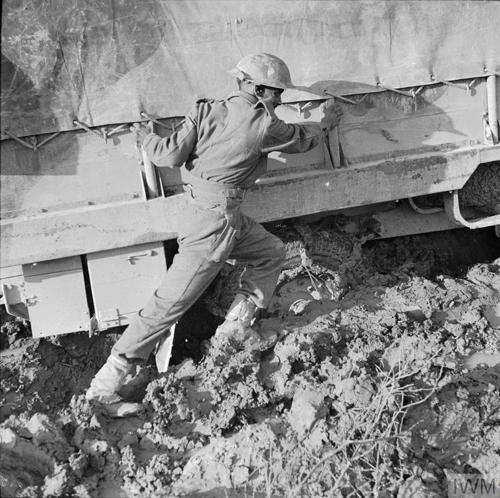 Image: Conditions in Italy worsened as the winter drew on. Here, an Indian soldier struggles to dislodge a truck from the cloying mud (© IWM NA 8925)
Image: Conditions in Italy worsened as the winter drew on. Here, an Indian soldier struggles to dislodge a truck from the cloying mud (© IWM NA 8925)
From 9 November onwards, Eighth Army cleared the areas around the Sangro in the face of intense German resistance. Heavy rain raised the river level causing four bridges to need to be constructed over the swollen Sangro.
By the end of November, the Sangro had been successfully crossed with Indian and New Zealand soldiers leading the way. Casualties had been high, but the river was crossed, and the eastern end of the Gustav Line breached, allowing the Allies to continue their difficult advance up the Adriatic coast.
Sangro River War Cemetery testifies to the tough conditions facing Eighth Army in their sector. Some 2,600 fallen servicemen are buried here. They are a mixture of faiths and nationalities, representing the multi-nation effort undertaken by the Allies to win the Italian campaign.
Reflecting this is the Sangro River Cremation Memorial. This is dedicated to some 500 Indian officers and enlisted men who died in Italy between September 1943 and April 1944 and who were cremated in accordance with their faith.
Moro River Canadian War Cemetery

As we touched on earlier, the Allied effort during the Italian campaign was a truly multinational effort; British, Canadian, Indian, Newfoundland, New Zealand, South African troops, supported by Australian airmen, and troops drawn from British territories in Africa, the Mediterranean and Middle East fought alongside United States, Polish, Greek, Free French and even Brazilian soldiers in Italy.
These units represented the nascent United Nations, the official name of the Allies during the Second World War, following the ‘Declaration by United Nations’ during the Arcadia Conference in January 1942.
One of the prominent forces of the Italian campaign which gained a notable reputation was the Canadians.
The 1st Canadian Division and 1st Canadian Army Tank Brigade were present from the invasion of Sicily onwards. They were key in breaking enemy defensive positions, capturing mountaintop strong points and grinding down Axis resistance.
Fording rivers also fell under the Canadian’s Italian remit.
The Moro River had to be crossed soon after the Sangro was traversed with December 1943 promising more tough fighting and treacherous river crossings.
On 6 December, the 1st Canadian Division crossed the Moro but faced stiff opposition. They managed to push their Wehrmacht opponents back but soon the Canadians were involved in a costly battle for the town of Ortona.
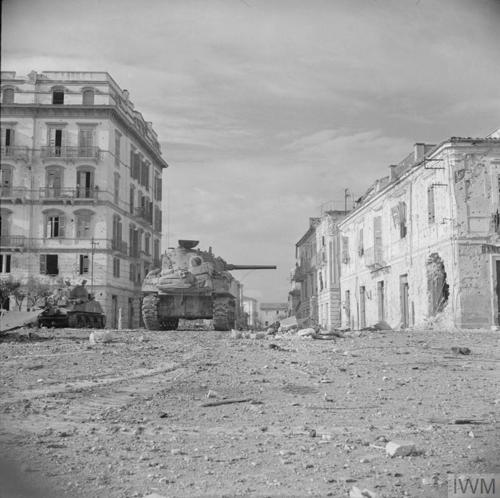 Image: Canadian Sherman tanks move through the blasted ruins of Ortona (© IWM NA 10203)
Image: Canadian Sherman tanks move through the blasted ruins of Ortona (© IWM NA 10203)
Ortona was a warren of steep, rubble-strewn medieval streets. Tanks couldn’t operate effectively in Ortona’s narrow lanes and alleyways while German troops had dug into the ruined buildings, sheltering in basements and cellars from Allied artillery fire meaning that the town had to be taken purely by infantry assault.
Rather than risk crossing the open and sniper- and machine gun-swept streets, the Canadians preferred to blast their way through walls and doorways house-to-house in a process they called “mouseholing”. After a week of tough hand-to-hand fighting, Ortona was in Allied hands by December 28.
December was a difficult and costly month for the Canadians. They suffered some 500 fatal combat casualties in that month alone. All told, some 26,000 Canadians would die in Italy during World War Two.
Moro River Canadian War Cemetery holds around 1,350 Canadian World War Two war graves. These men fell crossing the Moro, taking Ortona, or in the weeks that preceded and followed these battles.
Representing the multinational nature of the Italian Campaign, Moro River Canadian War Cemetery also contains around 250 or so non-Canadian war graves, including Australian, British, Indian, New Zealand, and South African servicemen.
Beach Head War Cemetery, Anzio

By Christmas 1943, it had become very clear that the Allies had become bogged down in Italy, and any further progress could only be achieved at great cost in men, materiel, and time.
Allied divisions and equipment had already begun to be withdrawn and sent to the United Kingdom in preparation for the cross-channel invasion of Normandy.
With dwindling resources and scant hope of receiving further significant reinforcements, Allied planners in Italy hoped that a bold and decisive strike could outflank the Axis forces on Italy’s eastern coast.
On 17 January 1944, Allied forces began to engage the Axis troops defending the eastern section of the Gustav Line between the sea and the hilltop monastery of Monte Cassino which formed a lynchpin of the Axis defences.
Allied planners began to think about how to bypass these troops. The answer was another seaborne operation.
Operation Shingle - an amphibious landing behind German lines at Anzio, some 50 kilometres south of Rome was put in motion.
The landings took place on 22 January. Three forces came ashore across the Anzio front: the British 1st Infantry Division landing north of Anzio, supported by two US landings in other nearby sectors.
Despite initial successes, and establishing a beachhead, the Allied assault stalled. Rather than moving out into the hills around Anzio as intended, the Allied troops were hemmed in by advancing German forces coming down from Northern Italy to relieve their comrades.
 Image: British troops hunker down in a German communication trench. The fighting at Anzio resembled that of the Western Front at times.
Image: British troops hunker down in a German communication trench. The fighting at Anzio resembled that of the Western Front at times.
The Allies were besieged, and the fighting around Anzio soon devolved into bitter trench warfare resembling that which their fathers and forebears had endured on the Western Front during the First World War: artillery bombardments, trench networks, attacks and counterattacks, night-time skirmishes and trench raids.
Malaria was rife with mosquitos rising from the reclaimed marshland around Anzio to torment the soldiers on both sides. The German Army had disabled the marsh draining system and flooded the land to impede the Allied advance.
The Anzio stalemate would last until 25 May 1944 after Cassino was finally taken. Those in the Anzio Beachhead were relieved by US forces, following the Allied breakthrough of the Gustav Line.
Prior to the breakout, the grinding stalemate at Anzio had resulted in some 7,000 Allied servicemen killed.
Beach Head War Cemetery today holds the graves of over 2,300 Commonwealth servicemen, many of whom died during the fierce fighting at Anzio.
The cemetery’s location lay close to a casualty clearing station, and the first burials were made directly from the battlefield following the landings. Later, many war graves were bought into Beach Head Cemetery after the Allies’ advance north.
Cassino War Cemetery

For any advance on Rome to succeed, Cassino had to be captured. General Herbert Alexander, Commander-in-Chief of the Allies in Italy, gave the go ahead to assault the mountain stronghold in January 1944.
The initial assault on Cassino, Operation Avenger, was a costly failure as Allied attacks were broken up by heavy and accurate artillery fire.
In mid-February, the Allies believing, incorrectly, that the Germans were using the Benedictine monastery atop Cassino as an observation point, bombed the monastery reducing much of it to rubble. In March, the town of Cassino was also targeted.
 Image: An Allied bomber passes over Monte Cassino (© IWM IA 15552)
Image: An Allied bomber passes over Monte Cassino (© IWM IA 15552)
Not only did the bombers obliterate a stunning historic building, but the barrage also essentially firmed up the German defence, creating many more strong points amidst the rubble German defenders could hole up in.
An infantry assault spearheaded by the 4th Indian Division and 28th New Zealand (Māori) Battalion captured some ground, including the Cassino railway station, but a lack of armour support pushed them back. During the attack, the Māori took a huge 60% wounded, killed or missing.
The burden of the fighting at Cassino fell on men rather than machines. Water, rations, and ammunition had to be brought by hand to forward positions, while getting a hot meal, washing, and shaving was often impossible.
Those wounded were particularly vulnerable and evacuating them proved perilous.
After the failure of piecemeal attacks over weeks and months, Allied commanders planned a major effort in May to finally break the stalemate. On 11 May a combined Allied offensive was launched, codenamed Operation Diadem.
With the aid of reinforcements, the town and the heights were secured within a week. Men of the Polish II Corps raised their flag above the ruins of the monastery on 18 May, and Allied forces linked up in the Liri Valley.
More than 4,000 war graves are in Cassino War Cemetery, representing the mammoth effort and cost in human life required to capture the strongpoint.
A further 4,000 servicemen who died during the whole Italian campaign and who have no known grave are commemorated on the Cassino Memorial within the cemetery.
Both the Cemetery and Memorial at Cassino were designed by Louis de Soissons and perhaps best illustrate how the architect drew on the architecture of antiquity for his designs. Note the mosaic tiles.
Cassino War Cemetery and the battle itself are a microcosm of the whole Italian campaign: a truly multinational effort that, while costly, eventually succeeded through expert cooperation between the Allies, carried by the determination and skill of the servicemen.
With the capture of Cassino, the road to Rome was open. German troops occupying the Eternal City evacuated when Field Marshal Kesselring decided to pull back from the Gustav Line. US troops under General Mark Clark entered the city on 4 June 1944.
Castiglione South African Cemetery

Two days later, on 6 June 1944, Allied forces stormed the Normandy beaches beginning the long-anticipated invasion of France.
News of the Normandy invasion overshadowed the achievements of the Allied forces in Italy, leading to the dismissive title of ‘D-Day Dodgers’ for those who served in Italy. Further Allied forces were withdrawn from Italy, some of whom took part in Operation Dragoon, the Allied invasion of Southern France.

Elsewhere on 6th June 1944, thousands of Commonwealth troops were fighting on Italy's tough battlefields. Discover more of their overlooked story today.
Learn about the D-Day DodgersNevertheless, those Allied forces who remained in Italy were able to push forward quickly in the wake of the Axis retreat north to the Gothic line, which ran north of Pisa and Florence along the Apennine Mountains, south of San Marino and along the river Foglia to Pesaro on the Adriatic coast.
This was the next major line of prepared defences barring the Allies from Northern Italy.
In early August, Allied forces began to close on the Gothic line and were once again faced with the daunting prospect of trying to break through yet another series of heavily fortified positions, having fought yard by yard for every hilltop and river valley, village, and town.
Part of the tragedy of the Italian campaign was the devastation it caused to villages, towns, and cities, many of which had stood since antiquity.
Many priceless treasures of the Renaissance, like the monastery at Monte Cassino, the many historic Florentine Bridges and countless works of art were damaged, looted or destroyed as the battling forces moved across the country.
But the chief tragedy was that which befell the civilian population, killed in air raids, in reprisals or by accident, and the privations and other hardships the Italian people had to endure.
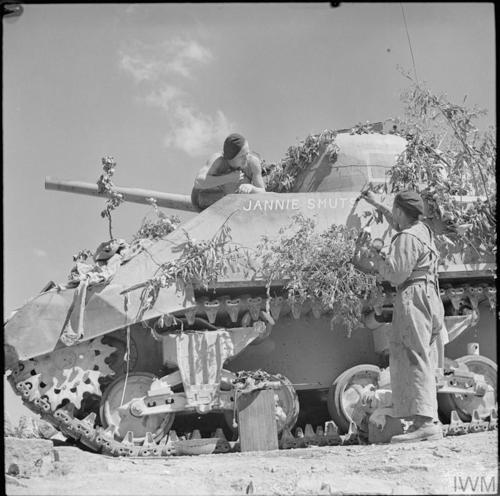 Image: South African tankers paint the name of the then Prime Minister, General Jan Smuts (© IWM NA 16225)
Image: South African tankers paint the name of the then Prime Minister, General Jan Smuts (© IWM NA 16225)
Castiglione lay just beyond the Gothic Line on the path to Bologna. The town was liberated on 27 September 1944 by the 6th South African Armoured Division, supported by British and Indian units, and quickly became a base of operations for the South African tankers moving forward.
Castiglione South African Cemetery was started in October 1944 to accommodate burials directly from the battlefields of the Apennines.
During the harsh winter of 1944, the South Africans held positions to the north of Castiglione.
The cemetery contains some 500 Commonwealth war graves, the majority of which are South African, many of whom died during October 1944. They are joined by men of the 24th Guards Brigade, which was seconded to the 6th South African Armoured Division.
Indian army troops holding and fighting in the Apennines are commemorated elsewhere, such as at Forli Indian War Cemetery and Forli Cremation Memorial.
Faenza War Cemetery

The winter of 1944-45 was particularly harsh. Late 1944 bought snow, wind, and rain to Italy, which impeded the Allies’ ability to advance.
Despite the harsh weather conditions and continued dogged Axis defence, the Allies were able to breach the central and western end of the Gothic line and push on towards Bologna.
Several towns and cities were captured before the end of the year as the Allies looked to further their gains before the winter weather prohibited major offensives.
One of the last battles fought in Italy in 1944 was the capture of Faenza by the 2nd New Zealand Division, supported by Polish and Indian units.
Faenza lay on the route to Bologna. Capturing Bologna would allow the Allies to get out of the Apennines and into more open country of the North Italian plain.
Three battles were fought to capture Faenza through November and December 1944. Ultimately a night attack on 14 December by the New Zealanders captured the city, helping clear the path for the taking of Bologna and the final phase of the war in Italy.
But such battles were not without cost.
Faenza War Cemetery holds the graves of over 1,150 Commonwealth servicemen, around half of whom died during the last months of 1944.
Argenta Gap War Cemetery

After nearly two years of fighting, Italy had earned the reputation as a ‘tough old gut’. It was not until April 1945 that the Allies were to renew their offensive and usher in the final phase of the Italian Campaign.
By now, thousands of servicemen on both sides had lost their lives. The weather had been appalling during the autumn and winter months of the war, although fighting up exposed mountains in blazing heat also affected troops badly.
Millions of civilians had lost their homes, their loved ones, or their lives.
Operation Grapeshot was the codename given to the Allied spring offensive in Italy. According to US General Mark Clark, commander of the US Fifth Army, its goal was to “destroy the maximum number of enemy forces south of the Po, force crossings of the Po, and capture Verona”.
On the western flank of the Allied advance, the US Fifth Army would have to dislodge German divisions from mountain defences and breakout into the north Italian plain while on the eastern flank, British Eighth Army had to cross a series of deep, high-sided, fortified rivers which snake across the north Italian plain, the greatest of which was the river Po.
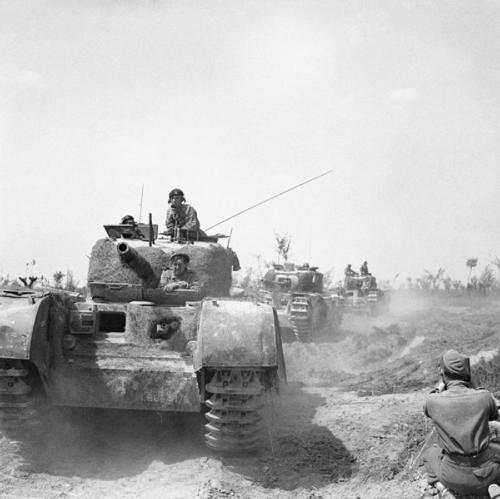 Image: British Churchill tanks during the advance on the Argenta Gap (Wikimedia Commons)
Image: British Churchill tanks during the advance on the Argenta Gap (Wikimedia Commons)
The Germans had flooded much of the low-lying land, between Bologna and Lake Comacchio leaving only a narrow strip the Allies called the Argenta Gap.
The offensive began on 6 April 1945; the British Eight Army smashed into the Argenta Gap and after five days of hard fighting was able to push through and send the German Tenth Army into full retreat.
Argenta Gap Military Cemetery was established shortly afterwards, chosen by the 78th Division for battlefield burials and later enlarged when burials were brought in from the surrounding district.
It contains, among others, the graves of many men of the Commandos who died during amphibious operations on the shores of the Comacchio lagoon early in April 1945.
Argenta Gap War Cemetery contains 625 Commonwealth burials of the Second World War, eight of them unidentified.
The cemetery is another design by Louis de Soissons, bearing the hallmarks of his Antiquity-inspired design and Romanesque design flourishes.
Victory in Italy

Image: A family lays flowers on the grave of an unknown British soldier (© IWM TR 1801)
While Eighth Army was charging through the Argenta Gap, the US Fifth Army assaulted and captured Bologna before pushing out into the plains before the Po River.
By the end of April, German resistance in Italy, which had been so formidable, was melting away like the winter snow.
On 29 April 1945 the German Commanders in Italy, General Vietinghoff and General Wollf, signed an instrument of surrender. The fighting formally ended a few days later, on 2 May 1945, when the agreed armistice came into effect.
The Italian Campaign had been long. It had been costly. The Allies had suffered over 375,000 casualties killed, captured, or wounded. They had taken over a million prisoners and liberated Italy from its Fascist occupiers but at a terrible price.
The Commonwealth War Graves Commission’s cemeteries and memorials in Italy help us understand the human cost paid by Commonwealth forces for victory in the Italian campaign of the Second World War.
Commonwealth servicemen and women are commemorated at 57 war cemeteries and 123 total locations across the country, from purpose-built war cemeteries and memorials to the missing and those cremated in accordance with their faith, to isolated graves and small burial plots in civilian cemeteries or churchyards.
Discover more about Commonwealth War Graves in Italy
Our search tools can help you learn more about those we commemorate in Italy.
Want to learn more about the fallen Commonwealth soldiers we commemorate there? Our Find War Dead tool can help. Simply filter by country to discover the Second World War casualties in our care.
If you’d like to learn more about the sites in Italy we maintain, use our Find Cemeteries & Memorials tool. Each cemetery page details the number of dead it commemorates, visiting information, and more.
What will you discover?

